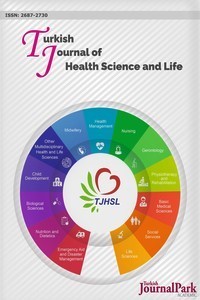INVESTIGATION OF THE RELATIONSHIP BETWEEN DENTAL TRAUMA IN CHILDREN AND SOME HEALTH PROBLEMS
INVESTIGATION OF THE RELATIONSHIP BETWEEN DENTAL TRAUMA IN CHILDREN AND SOME HEALTH PROBLEMS
Risk factors, Child Dental trauma,
___
- Lam, R. 2016. Epidemiology and outcomes of traumatic dental injuries: a review of the literature. Austr Dent J. 61(1): 4–20.
- Glendor U. 2008. Epidemiology of traumatic dental injuries–a 12 year review of the literature. Dent Traumatol, 24(6): 603-11.
- Baig, E, M, Marcenes W, Stansfeld SA, Bernabé E. 2016. Alcohol consumption at age 11-12 years and traumatic dental injuries at age 1516 years in school children from East London. Dent Traumatol, 32(5): 361-6.
- Kırzıoglu, Z., Öz, E. 2019. Changes in the Aetiological Factors of Dental Trauma in Children Over Time: An 18-year Retrospective Study. Dent Traumatol, 35(4-5): 259-67.
- Yetiş, C., Kırzıoğlu, Z. 2017. Dikkat Eksikliği ve Hiperaktivite Bozukluğu Olan Çocuklarda Ağız ve Diş Sağlığı Problemleri ve Çözüm Önerileri. J Pediatr Res, 4(3): 109-16.
- Andreasen JO, Ravn JJ. 1972. Epidemiology of traumatic dentalinjuries to primary and permanent teeth in a Danish population sample. Int J OralSurg, 1(5): 235-9.
- Bayram, H., Kılınç, O. (eds). Türk Toraks Derneği Astım ve Alerji Çalışma Grubu, Yönetim Kurulu-Rehber Hazırlama Komitesi. 2014. Türk Toraks Derneği Astım Tanı ve Tedavi Rehberi. Turkish Thoracic Journal, 10(10): 1-12.
- Pauwels, R.A., Pedrsen, S., Busse, W.W., Tan, W.C., Chen, Y.Z., Ohlsson, S.V., et al. 2003. Early intervention with budesonide in mild persistent asthma: a randomised, double-blind trial. Lancet, 361(9363): 1071-6.
- Childhood Asthma Management Program Research Group (CAMP). 2000. Long-term Effects of Budesonide or Nedocromil in Children With Asthma. N Engl J Med, 343(15): 1054-63.
- Xiang, H., Stallones, L., Chen, G., Hostetler, S.G., Kelleher, K. 2005. Nonfatal Injuries Among US Children With Disabling Conditions. Am J Public Health, 95(11): 1970-5.
- Nonato ER, Borges MA. 2011. Oral and maxillofacial trauma in patients with epilepsy prospective study based on an outpatient population. Arq Neuropsiquiatr, 69(3): 491–5.
- Kömerik, N., Kırzıoğlu, Z., Efeoğlu, C.G. 2012. Zihinsel engele sahip bireylerde ağız sağlığı. Atatürk Üniv Diş Hek Fak Derg, 22(1): 96-104.
- Ünal, A, Saygı S. 2005. Epilepsi Hastalarında Görülen Psikiyatrik Bozukluklar. Türkiye Klinikleri J Int Med Sci,1(40): 40-5.
- Turanlı, G. 1999. Epilepsi ve izlemi. Katkı Pediatri Dergisi, 20(3): 385-95.
- Pack, A.M., Morrell, M.J. 2001. Adverse effects of antiepileptic drugs on bone structure: epidemiology, mechanisms and therapeutic implications. CNS Drugs, 15(8): 633–42.
- Tunç, B. 2008. Çocuklarda Demir Eksikliği Anemisi. Türkiye Çocuk Hastalıkları Dergisi, 2(2): 43-57.
- Mattia, D.D., Pettini, P.L., Sabato, V., Rubini, G., Laforgia, A., Schettini, F. 1996. Oromaxillofacial changes in thalassemia major. Minerva Pediatr, 48(1-1): 11-20.
- Kataria, S.K., Arora, M., Dadhich, A., Kataria, K.R. 2012. Orodental complications and orofacial menifestation in children and adolescents with thalassaemia major of western Rajasthan population: a comparative study. Int J Biol Med Res, 3(2): 1816-9.
- Nyugen, Q.V., Bezemer, P.D., Habets, L. 1999. A systematic review of the relationship between overjet size and traumatic dental injuries. Eur J Orthod, 21(5): 503-15.
- Brin I, Ben-Bassat Y, Heling I, Engelberg A. 1991. The influence of orthodontic treatment on previously traumatized permanent incisors. Eur J Orthod, 13(5): 372-7.
- Hergüner, A., Erdur, A.E., Başçiftçi, F.A., Herguner, S. 2015. Attention-deficit/hyperactivity disorder symp toms in children with traumatic dental injuries. Dent Traumatol, 31(2): 140-3.
- Sabuncuoglu, O., Taser, H., Berkem, M. 2005. Relationship between traumatic dental injuries and attention-deficit/hyperactivity disorder in children and adolescents: proposal of an explanatory model. Dent Traumatol, 21(5): 249-53.
- ISSN: 2687-2730
- Başlangıç: 2018
- Yayıncı: Mümin POLAT
PEDIATRIC DENTISTRY AND DENTAL ANXIETY
INVESTIGATION OF THE RELATIONSHIP BETWEEN DENTAL TRAUMA IN CHILDREN AND SOME HEALTH PROBLEMS
STATUS OF THE ELDERLY'S EXPOSURE TO ABUSE: THE CASE OF SINOP WITH THE OLDEST POPULATION IN TURKEY
Hatice CEYLAN, Derya SAHİN, Bilge BAL ÖZKAPTAN
MEDICATION ADMINISTRATION ERROR REPORTING RATE AND PERCEIVED BARRIERS AMONG NURSES IN TURKEY
Ülkü GÜNEŞ, Leyla BARAN, Burcu CEYLAN
INVESTIGATION OF ENERGY DRINKS CONSUMPTION AND HABITS IN NURSING STUDENTS
Mümin POLAT, Serkan KÖKSOY, Canan DEMİR BARUTCU
